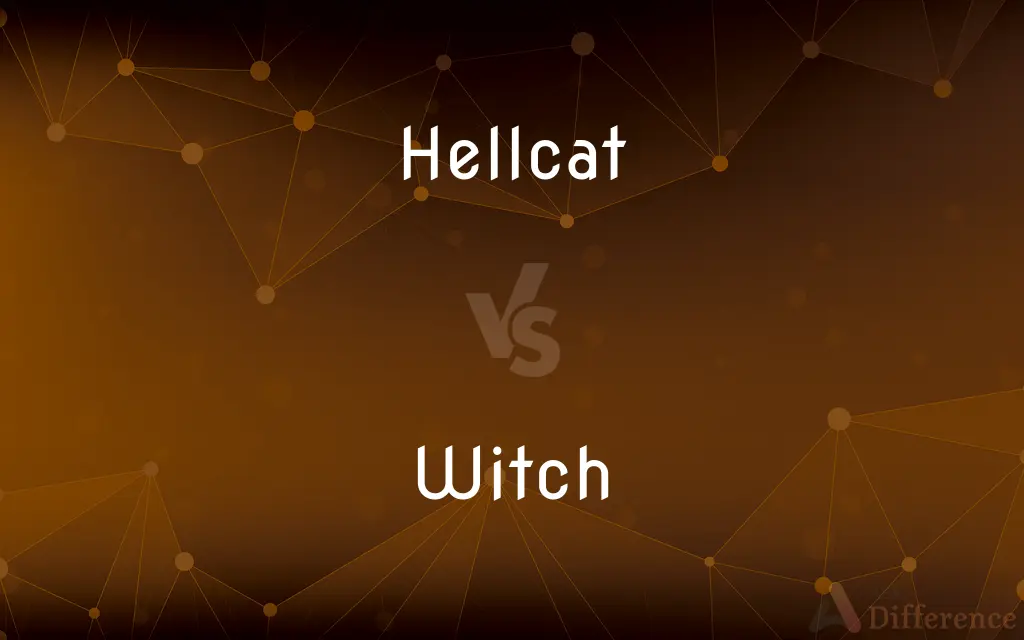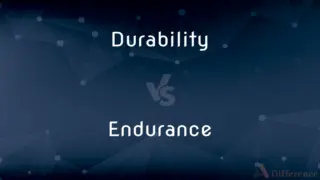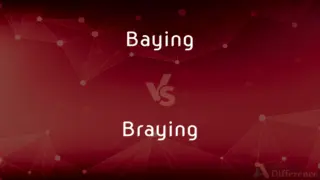Hellcat vs. Witch — What's the Difference?
By Maham Liaqat & Urooj Arif — Updated on March 31, 2024
Hellcat refers to a fiercely aggressive person or, historically, a powerful fighter aircraft, while a witch is associated with practicing magic, often portrayed in folklore and mythology.

Difference Between Hellcat and Witch
Table of Contents
ADVERTISEMENT
Key Differences
A hellcat, in colloquial usage, often describes someone with a fierce temper or aggressive demeanor, suggesting a comparison to a wild or ferocious animal. On the other hand, a witch is typically characterized as a person, usually a woman, who practices witchcraft or possesses magical powers, with portrayals ranging from benevolent to malevolent across different cultures.
The term "hellcat" also historically refers to the Grumman F6F Hellcat, a World War II American fighter aircraft known for its significant role in the Pacific theater. Whereas, witches have been subjects of folklore, mythology, and even historical persecution, such as during the witch trials in Europe and North America, without any direct connection to modern technological advancements or warfare.
Hellcats are associated with qualities of aggression and combativeness, either in the form of a person's temperament or the capabilities of the fighter aircraft. Witches, however, are linked with the mystical and supernatural, their identities deeply intertwined with cultural narratives of magic, healing, and sometimes curses.
While the concept of a hellcat is rooted in behavior or historical reference without inherent supernatural connotations, witchcraft encompasses practices and beliefs that engage with the supernatural, magic, and spiritual realms. The former is grounded in the physical world, whereas the latter transcends it.
The juxtaposition of these terms highlights the contrast between the tangible and intangible, the physical aggression or might against the mystical and magical. Hellcats, whether people or machines, operate within the realm of physical capabilities, while witches navigate the boundaries of the spiritual and supernatural.
ADVERTISEMENT
Comparison Chart
Definition
An aggressively temperamental person or a WW2 fighter aircraft.
A person, typically a woman, practicing witchcraft.
Origin
Colloquial or historical (military).
Folklore, mythology, and historical records.
Association
Aggression, combativeness, and physical might.
Magic, supernatural powers, and spirituality.
Cultural Perception
Often negative when describing a person; positive in military history.
Varies widely, from wise healers to malevolent figures.
Role and Impact
Personal temperament or military significance.
Cultural narratives, healing, or harm through magical practices.
Compare with Definitions
Hellcat
Refers to something or someone exceptionally tough or formidable.
She navigated the corporate ladder with the tenacity of a hellcat.
Witch
A practitioner of witchcraft, often possessing magical abilities.
The village witch was sought for her knowledge of herbal remedies.
Hellcat
An extremely aggressive or combative person.
She was known as a hellcat in the courtroom for her fierce litigation style.
Witch
Historically, a target of persecution for alleged magical practices.
Many women labeled as witches faced trials and executions in the 17th century.
Hellcat
Historically, a dominant WW2 American fighter aircraft.
The Hellcat played a crucial role in achieving air superiority in the Pacific.
Witch
Can symbolize a connection to nature or the spiritual realm.
She considered herself a modern witch, focusing on natural magic and healing.
Hellcat
Describes someone with a fiery temper.
His hellcat demeanor was infamous among his competitors.
Witch
Represents a figure of wisdom or malevolence in stories.
The witch in the story used her powers to protect the forest and its creatures.
Hellcat
Can imply a rebellious or unyielding nature.
His hellcat approach to negotiations earned him a mixture of respect and wariness.
Witch
In folklore, a character associated with spells and enchantments.
Witches in fairy tales often cast curses or brew potions.
Hellcat
A woman regarded as bad-tempered and evil.
Witch
A person, especially a woman, claiming or popularly believed to possess magical powers and practice sorcery.
Hellcat
A woman who practices sorcery; a witch.
Witch
A believer or follower of Wicca; a Wiccan.
Hellcat
A person who torments others.
Witch
(Offensive) An old woman considered to be ugly or frightening.
Hellcat
A witch.
Witch
A woman considered to be spiteful or overbearing.
Hellcat
A spiteful and violent person, especially a woman.
Witch
(Informal) A woman or girl considered to be charming or fascinating.
Hellcat
A malicious fierce-tempered woman
Witch
One particularly skilled or competent at one's craft
"A witch of a writer, [she] is capable of developing an intensity that verges on ferocity" (Peter S. Prescott).
Witch
To work or cast a spell on; bewitch.
Witch
To cause, bring, or effect by witchcraft.
Witch
To use a divining rod to find underground water or minerals; dowse.
Witch
A person who practices witchcraft.
Witch
(now usually particularly) A woman who is learned in and actively practices witchcraft.
Witch
An ugly or unpleasant woman.
I hate that old witch.
Witch
One who exercises more-than-common power of attraction; a charming or bewitching person.
Witch
One given to mischief, especially a woman or child.
Witch
(geometry) A certain curve of the third order, described by Maria Agnesi under the name versiera.
Witch
The storm petrel.
Witch
Any of a number of flatfish:
Witch
Glyptocephalus cynoglossus (Torbay sole), found in the North Atlantic.
Witch
Lepidorhombus whiffiagonis (megrim), found in the North Atlantic.
Witch
Arnoglossus scapha, found near New Zealand.
Witch
The Indomalayan butterfly Araotes lapithis, of the family Lycaenidae.
Witch
A cone of paper which is placed in a vessel of lard or other fat and used as a taper.
Witch
(intransitive) To dowse for water.
Witch
To practise witchcraft.
Witch
(transitive) To bewitch.
Witch
A cone of paper which is placed in a vessel of lard or other fat, and used as a taper.
Witch
One who practices the black art, or magic; one regarded as possessing supernatural or magical power by compact with an evil spirit, esp. with the Devil; a sorcerer or sorceress; - now applied chiefly or only to women, but formerly used of men as well.
There was a man in that city whose name was Simon, a witch.
He can not abide the old woman of Brentford; he swears she's a witch.
Witch
An ugly old woman; a hag.
Witch
One who exercises more than common power of attraction; a charming or bewitching person; also, one given to mischief; - said especially of a woman or child.
Witch
A certain curve of the third order, described by Maria Agnesi under the name versiera.
Witch
The stormy petrel.
Witch
A Wiccan; an adherent or practitioner of Wicca, a religion which in different forms may be paganistic and nature-oriented, or ditheistic. The term witch applies to both male and female adherents in this sense.
Witch
To bewitch; to fascinate; to enchant.
[I 'll] witch sweet ladies with my words and looks.
Whether within us or withoutThe spell of this illusion beThat witches us to hear and see.
Witch
A female sorcerer or magician
Witch
A being (usually female) imagined to have special powers derived from the devil
Witch
An ugly evil-looking old woman
Witch
Cast a spell over someone or something; put a hex on someone or something
Common Curiosities
Can the term "hellcat" be used positively?
Yes, especially when referring to the WW2 aircraft, it carries a positive connotation of strength and heroism.
Is there a modern equivalent to a hellcat?
In modern usage, "hellcat" remains a descriptor for someone with a fierce or combative personality, rather than a specific role or occupation.
How do witches practice their craft today?
Contemporary witches often engage in practices related to spirituality, nature, and healing, embracing a wide range of magical traditions.
How is the concept of a witch viewed across different cultures?
Views on witches vary widely, from respected healers and wise figures to feared or evil entities.
What historical impact did witches have?
Witches have significantly influenced cultural narratives, folklore, and even historical events, such as the witch trials.
Were all witches historically considered evil?
Not all; some were viewed as wise healers or protectors, though many narratives, especially during witch hunts, cast them as malevolent.
What makes someone a "hellcat" in behavior?
Demonstrating a particularly aggressive, tenacious, or unyielding demeanor qualifies someone as being described as a hellcat.
What differentiates a hellcat from a witch?
A hellcat is known for aggressive temperament or historical military significance, while a witch is associated with practicing witchcraft or possessing magical powers.
Are witches always female?
While traditionally depicted as women, witches can be of any gender in modern interpretations and practices of witchcraft.
Can the practice of witchcraft be learned?
Yes, it encompasses a wide range of knowledge and skills, from herbalism to ritual magic, that can be studied and practiced.
What was the purpose of the F6F Hellcat aircraft?
Its primary role was as a carrier-based aircraft in WW2, designed to gain air superiority for the Allies.
How do media and literature portray witches?
They vary from evil villains and seductive figures to wise sages and protectors, reflecting diverse cultural attitudes.
Does the term "hellcat" have any relation to the supernatural?
Unlike "witch," "hellcat" does not inherently relate to the supernatural, focusing more on temperament or historical military prowess.
Can witchcraft be practiced without belief in the supernatural?
Yes, some view witchcraft as a symbolic practice or a way to connect with nature, rather than a literal belief in magic.
What societal roles have witches been ascribed?
Depending on the context, witches have been healers, midwives, wise women, or scapegoats for societal ills.
Share Your Discovery

Previous Comparison
Durability vs. Endurance
Next Comparison
Baying vs. BrayingAuthor Spotlight
Written by
Maham LiaqatCo-written by
Urooj ArifUrooj is a skilled content writer at Ask Difference, known for her exceptional ability to simplify complex topics into engaging and informative content. With a passion for research and a flair for clear, concise writing, she consistently delivers articles that resonate with our diverse audience.
















































